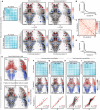Structural and genetic determinants of zebrafish functional brain networks
- PMID: 40644546
- PMCID: PMC12248300
- DOI: 10.1126/sciadv.adv7576
Structural and genetic determinants of zebrafish functional brain networks
Abstract
Network science has revealed universal brain connectivity principles across species. However, several macroscopic network features established in human neuroimaging studies remain underexplored at cellular scales in small animal models. Here, we use whole-brain calcium imaging in larval zebrafish to investigate the structural and genetic basis of functional brain networks. Mesoscopic functional connectivity (FC) robustly captures the individuality of larvae and reflects structural connectivity (SC) derived from single-neuron reconstructions. Several connectome properties, including diffusion mechanisms and indirect pathways, predict interregional correlations. SC and FC share a hierarchical modular architecture, with structural modules shaping spontaneous and stimulus-driven activity patterns. Visual stimuli and tail monitoring reveal a functional gradient that coincides with sensorimotor functions. Last, regional expression levels of specific genes predict interregional FC. Our findings reproduce key mammalian brain network features, demonstrating larval zebrafish as a powerful model for studying large-scale network phenomena in a small and optically accessible vertebrate brain.
Figures







Similar articles
-
Sex differences and age-related changes of large-scale brain networks.BMC Med Imaging. 2025 Jul 6;25(1):271. doi: 10.1186/s12880-025-01811-0. BMC Med Imaging. 2025. PMID: 40619358 Free PMC article.
-
Short-Term Memory Impairment.2024 Jun 8. In: StatPearls [Internet]. Treasure Island (FL): StatPearls Publishing; 2025 Jan–. 2024 Jun 8. In: StatPearls [Internet]. Treasure Island (FL): StatPearls Publishing; 2025 Jan–. PMID: 31424720 Free Books & Documents.
-
Diffusion wavelets on connectome: Localizing the sources of diffusion mediating structure-function mapping using graph diffusion wavelets.Netw Neurosci. 2025 Jun 27;9(2):777-797. doi: 10.1162/netn_a_00456. eCollection 2025. Netw Neurosci. 2025. PMID: 40612714 Free PMC article.
-
Functional brain connectivity in children with focal epilepsy: A systematic review of functional MRI studies.Seizure. 2024 Apr;117:164-173. doi: 10.1016/j.seizure.2024.02.021. Epub 2024 Feb 28. Seizure. 2024. PMID: 38432080
-
Attention Please! Unravelling the Link Between Brain Network Connectivity and Cognitive Attention Following Acquired Brain Injury: A Systematic Review of Structural and Functional Measures.Brain Connect. 2024 Feb;14(1):4-38. doi: 10.1089/brain.2023.0067. Epub 2024 Jan 9. Brain Connect. 2024. PMID: 38019047
References
-
- Ryan T. J., Grant S. G., The origin and evolution of synapses. Nat. Rev. Neurosci. 10, 701–712 (2009). - PubMed
-
- Van den Heuvel M. P., Bullmore E. T., Sporns O., Comparative connectomics. Trends Cognit. Sci. 20, 345–361 (2016). - PubMed
-
- Bullmore E., Sporns O., The economy of brain network organization. Nat. Rev. Neurosci. 13, 336–349 (2012). - PubMed
MeSH terms
LinkOut - more resources
Full Text Sources

